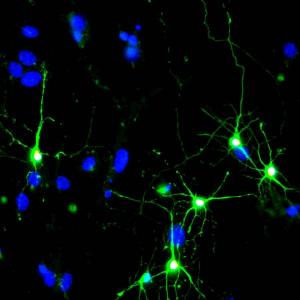Functional nerve cells can be created from astroglia, which are brain support cells, by using special regulatory proteins

The research group of Prof. Magdalena Gotz at the Institute for Stem Cell Research at GSF - the National Tender for Environmental and Health Research and the Ludwig Maximilians University, Munich, managed to advance another step towards the potential replacement of damaged brain cells after injury or disease: functional nerve cells can be created from astroglia, which are support cells in the brain, by using special regulatory proteins.
Most of the cells in the human brain are not nerve cells but star-shaped glial cells, astroglia. "Glia means glue," Goetz explains. "In a way that matches their name, until today these cells were considered a kind of glue that keeps the nerve cells together."
A few years ago, the research group was able to prove that glial cells serve as stem cells during development. This means that these cells are able to develop into functional neurons. But, this feature disappears in later stages of development so that even after a brain injury in an adult these cells do not produce additional nerve cells.
In order to be able to reverse this developmental process, the research group learned which molecular switches are essential for the generation of neurons from glial cells during development. These regulatory proteins are introduced into glial cells in the postnatal brain, which do respond by activating the expression of neural proteins.
In his current study, Dr. Benedict Berninger was able to show that a few regulatory proteins are sufficient to create nerve cells from glial cells. The transition from glial to nerve can be monitored in real time by a time-lapse microscope. It has been demonstrated that glial cells need several days to 'reprogram' and reach the characteristic shape of nerve cells. "These new nerve cells have the normal electrical characteristics of nerve cells," stresses Berninger. "We can prove this by electrical measurements."
"Our results are very encouraging, since the creation of properly functioning nerve cells from postnatal glial cells (after birth) is an important step on the way to being able to replace nerve cells after brain injuries," emphasizes Magdalena Gotz.
For the announcement in English of the German Research Center

2 תגובות
With the help of nanotechnology, anything is possible. . .
So it can help or cure stroke victims in which brain cells are damaged!!
This is an interesting and not widely known direction (like me it is not found in depth) .. the question now is how to "convince" the activated glial cells to reach the damaged cells and replace them!
If it succeeds, it's a great idea that bypasses the problems with the stem cells (professionalism and ethics)!
And one more thing... how will they get to those glial cells? with surgery? If drilling a small hole in the head and using imaging equipment will do the job...it will be much more practical and faster and increase the chances of success, but if it involves opening the head (some surgeons love it..an open and bleeding head!!) ..then..